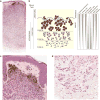Melanocytic nevi and melanoma: unraveling a complex relationship
- PMID: 28604751
- PMCID: PMC5930388
- DOI: 10.1038/onc.2017.189
Melanocytic nevi and melanoma: unraveling a complex relationship
Abstract
Approximately 33% of melanomas are derived directly from benign, melanocytic nevi. Despite this, the vast majority of melanocytic nevi, which typically form as a result of BRAFV600E-activating mutations, will never progress to melanoma. Herein, we synthesize basic scientific insights and data from mouse models with common observations from clinical practice to comprehensively review melanocytic nevus biology. In particular, we focus on the mechanisms by which growth arrest is established after BRAFV600E mutation. Means by which growth arrest can be overcome and how melanocytic nevi relate to melanoma are also considered. Finally, we present a new conceptual paradigm for understanding the growth arrest of melanocytic nevi in vivo termed stable clonal expansion. This review builds upon the canonical hypothesis of oncogene-induced senescence in growth arrest and tumor suppression in melanocytic nevi and melanoma.
Conflict of interest statement
The authors declare no conflict of interest.
Figures






References
-
- Hayflick L, Moorhead PS. The serial cultivation of human diploid cell strains. Exp Cell Res. 1961;25:585–621. - PubMed
-
- Hayflick L. The limited in vitro lifetime of human diploid cell strains. Exp Cell Res. 1965;37:614–636. - PubMed
-
- Harley CB, Futcher AB, Greider CW. Telomeres shorten during ageing of human fibroblasts. Nature. 1990;345:458–460. - PubMed
Publication types
MeSH terms
Substances
Grants and funding
LinkOut - more resources
Full Text Sources
Other Literature Sources
Medical
Molecular Biology Databases
Research Materials

